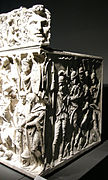Portonaccio sarcophagus

The Portonaccio sarcophagus is a 2nd-century ancient Roman sarcophagus found in the Portonaccio quarter of Rome and now held at the Museo Nazionale Romano (palazzo Massimo). Dating to between 190 and 200, it was used for the burial of a Roman general involved in the campaigns of Marcus Aurelius and shows influences similar to those of the Column of Marcus Aurelius.
The sarcophagus is one of a group of about twenty-five late Roman battle sarcophagi, with one exception all apparently dating to 170-210, made in Rome or in some cases Athens. These derive from Hellenistic monuments from Pergamon in Asia Minor showing Pergamene victories over the Gauls, and were all presumably commissioned for military commanders. The Portonaccio sarcophagus is the best known and most elaborate of the main Antonine group, and shows both considerable similarities to the Great Ludovisi sarcophagus, the late outlier from about 250, and a considerable contrast in style and mood.[1]
The face of the general is unfinished, either because the sculptors awaited a model to work from, or they had produced the work speculatively with no specific commission. The general and his wife are also each shown twice on the lid frieze, together holding each other's hands at the centre, and singly at the ends, again with unfinished faces.[2] Pairs of figures of an older man and a woman stand beneath trophies at either end of the main face, uninvolved in the battle. These are at the same scale as the general, and all other the battling figures are smaller; indeed, in defiance of any attempt at perspective, the soldiers and horses at the "front" of the scene in the lower part are somewhat smaller than their equivalents at the "back" in the upper part.
-
Left side
-
Right side
-
Detail of front, to left
-
Detail of front, to centre, with the general
-
Detail of front, to right
-

Detail of barbarians
-
-
-
Trophies at the side of the front
References
| Wikimedia Commons has media related to Portonaccio sarcophagus. |







